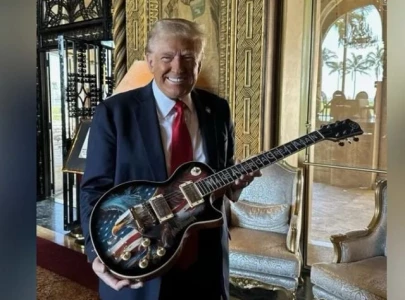
The week that went by, was dominated by a strange combination of dharnas, defections and disqualifications. Fascinating stuff, this — but not more so than the mathematics of the contest. Numbers tell stories, and these numbers adding up to 137 are weaving a tale of burning ambition, cut-throat competition and heart-wrenching betrayal.
Hidden within the coarse folds of this electoral tapestry is a curious possibility: the PML-N may win fewer seats than the PTI and yet cross the magical number of 137 before the PTI. How does this work?
The National Assembly has 272 directly elected seats up for grabs. Any party or coalition that can garner the simple majority of 137 shall form the government at the Centre and elect its prime minister. At this stage, it looks unlikely that any single party will win the required 137 seats to be able to form the government on its own. This means the PTI and the PML-N — expected as they are to emerge as the two largest parties — will need to stitch together an alliance to cross the magic number of 137. And here’s where the curious part kicks in.
The PTI will need to hit the 100 mark if it wants to be in the safe victory zone. Short of that, it will be treading slippery ground — slippery enough for the party to tumble into the opposition benches despite being the single largest party. Here’s why: if Imran and his team can win 100 seats (or thereabouts) they would be 37 short of catapulting their leader into the Prime Minister’s House. These 37 seats will not be hard to manage. If the PSP, MQM, PML-Q, PML-F, BAP and a ragtag team of independents are herded together, their combined seats can add up to 37. The PTI will then bring this alphabet soup of parties on board its coalition and shove the PML-N and the PPP to the opposition benches.
Fate says to Imran: Get 100 seats — become the prime minister of Pakistan.
But fate can be tricky. And thorny. And notoriously unfair. For isn’t it unfair that while the PTI needs 100 seats to form the next government, the PML-N may only need 80 to do the same. What gives?
Enter in the equation a party that is known for its rather un-envious attributes: incompetence, inefficiency, ineptitude, corruption, nepotism and jobbery. Oh and also a kitty of forty-odd seats at the least. The PPP is the party that the PTI wants nothing to do with. The PPP is the party that will willingly join the PML-N — despite all protestations to the contrary — if it means forming a ruling coalition.
It could, in fact, mean forming a ruling coalition. If the PML-N gets 80 seats and the PPP can muster 40 seats, the grand total adds up to 120 seats. That’s only 17 seats short of crossing the magic figure of 137. With the MMA and a few other options, including independents thrown in, the shortfall of 17 seats will not be too hard to conjure up.
Fate says to the PML-N: Get 80 seats — get back into power in Islamabad.
PML-N won’t respond to ‘dissenting voices’, say party leaders
How hard is it then for the PML-N to rack up 80 seats? In the 2013 elections, the party bagged more than a hundred seats just from Punjab. This is not likely to happen this year. But neither will a PML-N wipeout take place. If the PML-N can hold on to its core in north and central Punjab, or at least put up a tough fight despite all odds, it can aim for 60 seats from Punjab. This could take its national tally somewhere near the 80 mark. Till a few weeks ago though, even the 80 mark looked an uphill task. And now?
This is where these last six days come in. The PTI’s entire electoral strategy is encapsulated in one word: Electables. Imran Khan has said repeatedly he aims to win the elections by fielding the best and most winnable electable candidates regardless of who they are and what they have done or not done in the life before the PTI. The second part of this strategy is to deprive the PMLN of key electables — especially in Punjab — and thereby snatch these seats away from the Sharifs. All this was supposed to start happening the day Nawaz Sharif was disqualified in July 2017.
And it did happen. Bit by excruciating bit, the fringe began to wither away from the PML-N on one flimsy pretext or the other. The South block went first, followed by those who calculated their chances of winning on a PTI ticket to be better. The steady trickle of defections continued through the first half of the year. And people waited for the trickle to transform into a deluge.
PML-N announces candidates for National Assembly seats
The deluge was expected once the PML-N government finished its term and stepped down from power. The date came and went. And yet the core held together. The jostling for tickets picked up steam in June and many more PML-N electables broke away for greener pastures. Most bandaged their wounds of shame with the green scarf of the PTI. And yet the deluge never came.
Six days from now — June 30, 2018 — the Election Commission will lock the final list of candidates for the elections. No aspirant will then have any real incentive to break away from a party and join any other party for the greed of a ticket. In six days, all electoral doors for seats will be slammed shut. And locked. In six days, no PML-N candidate will have any real incentive left to join the PTI because in six days the final battle lines would have been drawn.
If the PML-N does not rupture and splinter into pieces in the next six days, it will walk into the July 25th battleground with pretty decent odds. The party has almost finalised its tickets and the candidates in Punjab are no walkover. It will be a brutal fight between the PTI and the PML-N in Punjab no doubt; a fight that will be fought constituency to constituency, electable to electable, narrative to narrative under the full glare of an intrusive and partisan media.
Six days can pass in the blink of an eye — or last for an eternity.
Published in The Express Tribune, June 24th, 2018.
Like Opinion & Editorial on Facebook, follow @ETOpEd on Twitter to receive all updates on all our daily pieces.



1732626034-0/BeFunky-collage-(92)1732626034-0-165x106.webp)








COMMENTS (1)
Comments are moderated and generally will be posted if they are on-topic and not abusive.
For more information, please see our Comments FAQ